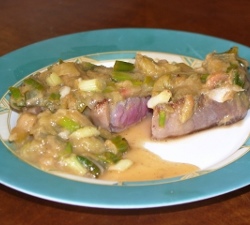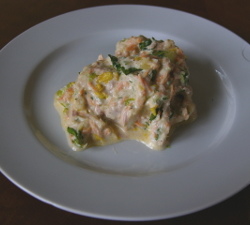In Germany Christmas means stollen, a traditional spiced fruit cake. Since my childhood, when my family would receive two or three stollen as gifts each December (in exchange for a package of coffee or chocolate), I only start to feel like it's Christmas when the stollen is cut.
I haven't found any really good low-carb recipes for Christmas stollen online. So I'm happy to announce that Delicious Low Carb is presenting the world's first fully-functioning low-carb stollen recipe. I have to admit that it took a lot of preparation (I wouldn't call it work) before we could taste it for the first time.
The dough for the stollen definitely wasn't the hardest part. A good stollen stands or falls on the ingredients that are mixed into the dough. Candied lemon and orange peel and raisins, all common ingredients, consist almost entirely of sugar. Since we'd been using sugar alcohol in our kitchen for some time already, and these have almost exactly the same properties in cooking as ordinary sugar, it made sense to look for a solution there. And we found one: it's possible to make low-carb candied fruit.
We made our candied citrus peels from scratch. We used candied plums as a substitute for the raisins, and they worked just as well.
Here are our instructions for Christmas stollen in several sections:
Low Carb Kandieren
Published on: Apr 19 2021, 18:29
Kandieren ist ein langwieriger Prozess. Sinn der Sache ist es, Früchten ihre Flüssigkeit zu entziehen und dafür große Mengen an Zucker einzulagern. Dies macht die kandierten Früchte dann auch gut haltbar. Wir haben dafür natürlich keinen Zucker eingesetzt, sondern unseren Low Carb Ersatzstoff Erythrit ( Handelsnamen: Sukrin, Erythritol, Sucolin, Xucker Light). Das erste Problem ist, dass Erythrit nicht ganz billig ist und wir davon zum Kandieren relativ große Mengen brauchen. Wir haben für eine…
1. LC Weihnachts-Stollen
Published on: Apr 19 2021, 18:47
Ein richtiger Christ-Stollen (Dresdner Stollen darf man eigentlich nicht sagen, da sich findige Dresdner Bäcker diesen Begriff frecherweise haben schützen lassen) besteht aus einem schweren Hefeteig. Da Hefe zum Gehen unbedingt Kohlenhydrate braucht, nutzen wir hier wieder unseren altbewährten Trick mit dem Vorteig. Dazu werden ca. 30 g normales Weizenmehl mit vier Päckchen Trockenhefe vermischt. Nach Zugabe von 300 ml warmer Milch und gründlichem Durchrühren erhält die Hefe nun eine halbe Stunde…






